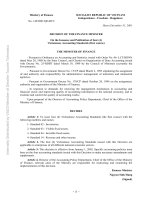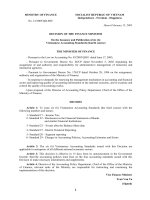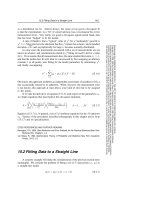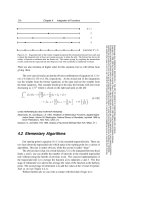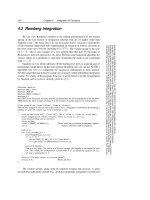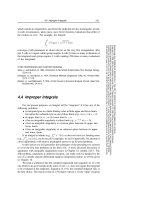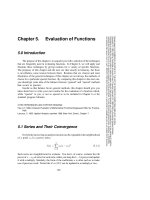Tài liệu GOVERNANCE OF THE EXTENDED ENTERPRISE docx
Bạn đang xem bản rút gọn của tài liệu. Xem và tải ngay bản đầy đủ của tài liệu tại đây (1.42 MB, 227 trang )
GOVERNANCE OF THE
EXTENDED ENTERPRISE
Bridging Business and IT Strategies
IT Governance Institute
John Wiley & SonsGOVERNANCE OF THE
EXTENDED ENTERPRISEGOVERNANCE OF THE
EXTENDED ENTERPRISE
Bridging Business and IT Strategies
IT Governance Institute
John Wiley & Sons
This book is printed on acid-free paper.
Copyright © 2005 by the IT Governance Institute. All rights reserved.
Published by John Wiley & Sons, Inc., Hoboken, New Jersey.
Published simultaneously in Canada.
No part of this publication may be reproduced, stored in a retrieval system, or
transmitted in any form or by any means, electronic, mechanical, photocopying,
recording, scanning, or otherwise, except as permitted under Section 107 or 108 of
the 1976 United States Copyright Act, without either the prior written permission
of the Publisher, or authorization through payment of the appropriate per-copy fee
to the Copyright Clearance Center, Inc., 222 Rosewood Drive, Danvers, MA 01923,
978-750-8400, fax 978-646-8600, or on the web at www.copyright.com. Requests to
the Publisher for permission should be addressed to the Permissions Department,
John Wiley & Sons, Inc., 111 River Street, Hoboken, NJ 07030, 201-748-6011, fax
201-748-6008, e-mail:
Limit of Liability/Disclaimer of Warranty: While the publisher and author have
used their best efforts in preparing this book, they make no representations or
warranties with respect to the accuracy or completeness of the contents of this book
and specifically disclaim any implied warranties of merchantability or fitness for a
particular purpose. No warranty may be created or extended by sales representatives
or written sales materials. The advice and strategies contained herein may not be
suitable for your situation. You should consult with a professional where appropriate.
Neither the publisher nor author shall be liable for any loss of profit or any other
commercial damages, including but not limited to special, incidental, consequential,
or other damages.
For general information on our other products and services, or technical support,
please contact our Customer Care Department within the United States at
800-762-2974, outside the United States at 317-572-3993 or fax 317-572-4002.
Wiley also publishes its books in a variety of electronic formats. Some content that
appears in print may not be available in electronic books.
For more information about Wiley products, visit our Web site at www.wiley.com.
Disclaimer
The IT Governance Institute (ITGI), Information Systems Audit and Control
Association and the authors of Governance of the Extended Enterprise have designed
the publication primarily as an educational resource for control professionals. ITGI,
ISACA, and the authors make no claim that use of this product will assure a successful
outcome. The publication should not be considered inclusive of any proper procedures
and tests or exclusive of other procedures and tests that are reasonably directed to
obtaining the same results. In determining the propriety of any specific procedure
or test, the controls professional should apply his/her own professional judgment to
the specific control circumstances presented by the particular systems or information
technology environment.
Library of Congress Cataloging-in-Publication Data:
ISBN: 0-471-33443-X
Printed in the United States of America
10987654321
About the Author
IT Governance Institute
®
The IT Governance Institute (ITGI) (www.itgi.org) was established in 1998
to advance international thinking and standards in directing and controlling
an enterprise’s information technology. Effective IT governance helps ensure
that IT supports business goals, optimizes business investment in IT, and
appropriately manages IT-related risks and opportunities. The IT Governance
Institute offers symposia, original research, and case studies to assist enter-
prise leaders and boards of directors in their IT governance responsibilities.
Information Systems Audit
and Control Association
®
With more than 35,000 members in more than 100 countries, the Infor-
mation Systems Audit and Control Association (ISACA
®
) (www. isaca.org)
is a recognized worldwide leader in IT governance, control, security, and
assurance. Founded in 1969, ISACA sponsors international conferences,
publishes the Information Systems Control Journal
™
, develops international
information systems auditing and control standards, and administers the
globally respected Certified Information Systems Auditor
™
(CISA
®
) desig-
nation, earned by more than 35,000 professionals since inception, and the
Certified Information Security Manager
™
(CISM
™
) designation, a ground-
breaking credential earned by 5,000 professionals in its first two years.
v
Acknowledgments xi
Preface xv
Introduction 1
Managing Change as a Business Process 2
How Do We Get There from Here? 3
Vision/Leadership 3
Value Creation and Performance Management 4
Governance Framework and Criteria 4
Governance Officer 6
Enterprise Architecture: Framework and Implementation 6
Reference Works 7
Looking Forward 9
1 Extended Enterprises 11
Change Agents in the Extended Enterprise Environment 11
Paradigm Shift in the Business Environment/Changes in
Processes 15
2 Strategy: Challenge for the Extended Enterprise 19
Business Strategy Challenge 19
New Enterprise Risk Management Structures 20
New Regulatory Compliance Challenge 21
Developing Strategy with Value Innovation 23
Transforming Internal Governance Strategy 25
New Internal Governance Challenge 27
Governance Challenge 27
vii
Bridging the Gap between the Information Technology
Organization and Internal Clients 28
Making Strategy a Continual Process: Coevolving
and Patching 29
Managing Knowledge for Better Communication:
Knowledge Management 30
Sharing Knowledge through a Knowledge Portal 32
3 Value Creation and Management of Performance in the
Extended Enterprise 35
Vision and Mission 35
Value Creation and Strategy Implications 36
Necessity of a Core Repository of Knowledge Portal 37
Suggested Architecture for Performance Measurement 37
Delegate and Empower through Performance Management 39
Framework for Measurement 40
Control Objectives for Information and Related Technology 43
Monitoring: Measuring and Comparing Outcomes for
Improvements 44
Ongoing Strategy Process: Operational Performance
Monitoring 45
4 Operational Business Activities: Value Realization
for the Extended Enterprise 49
Value Realization 49
Blueprint for Knowledge Sharing in an Extended Enterprise 52
Objectives, Goals, and Expectations 54
Information and Knowledge Resources
(Intangible Business Resources) 54
Information Sharing Activities (Two-way Communication) 57
Operational Business Activities 58
Tangible Business Resources 58
Value Creation Cycle 58
5 Governance Framework for the Extended Enterprise 61
Governance Definition 61
Enterprise Governance Challenge in the Extended Enterprise 64
Governance Structure for the Extended Enterprise 67
viii Contents
Governance Objectives for the Extended Enterprise 70
Comparison with Excellence Models 74
Leadership: Driver for Values and Governance Implementation 76
Maturity Levels of Leadership 77
Maturity Model for Evaluating the Level of Governance of the
Extended Enterprise 78
Tools for the Governance of the Extended Enterprise 79
6 Enterprise Architecture: Governance Implementation
for the Extended Enterprise 87
What Is Enterprise Architecture? 87
Enterprise Architecture: New Focus for
Chief Information Officers 87
Architecture Layers Interrelationships 93
Implementing and Maintaining the Enterprise Architecture 94
Information Technology Governance in the
Extended Enterprise 95
Strategic Alignment of IT Strategies with the Business 96
IT Infrastructure to Enable Business 97
Maturity Model of the Enterprise Architecture/IT Architecture 98
Partner Ability for Networking/Information Flows and
Relationships 100
Maturity Model for IT Governance 101
Establish Information Model and Data Model for
Quick Implementation of a Knowledge Base 102
Appendices
A Questions for the Board and Senior Management 105
B Performance Reference Model 113
C Organizational Structure Evolution: Core versus Central 123
D Framework and Quality Awards 127
E Business Reference Model 137
F Knowledge Work, Knowledge Management, and
Knowledge Portal 143
G Enterprise Architecture Processes at Different
Maturity Levels 151
H Maturity Model for Business Activities in the
Extended Enterprise 161
Contents ix
I IT Governance 167
J IT Governance Maturity Model 179
K COBIT Information Processes 185
Glossary 187
References 191
Other ITGI Publications 197
Index 201
x Contents
Acknowledgments
IT Governance Institute wishes to recognize:
Ⅲ
The Ministry of International Trade and Industry, Japan, for its
sponsorship of the project.
Ⅲ
The Board of Trustees, for its support of the project:
Marios Damianides, CISA, CISM, CA, CPA, Ernst & Young LLP,
United States, International President
Abdul Hamid Bin Abdullah, CISA, CPA, FIIA, Auditor General’s
Office, Singapore, Vice President
William C. Boni, CISM, Motorola, United States, Vice President
Ricardo Bria, CISA, SAFE Consulting Group, Spain,
Vice President
Everett C. Johnson, CPA, Deloitte & Touche LLP, United States,
Vice President
Howard Nicholson, CISA Mortgage Choice, Australia, Vice
President
Bent Poulsen, CISA, CISM, VP Securities Services, Denmark, Vice
President
Frank Yam, CISA, CIA, CCP, CFE, Focus Strategic Group Inc.,
Hong Kong, Vice President
Robert S. Roussey, CPA, University of Southern California, United
States, Past International President
Paul A.Williams, FCA, Paul Williams Consulting, United Kingdom,
Past International President
Emil D’Angelo, CISA, CISM, Bank of Tokyo-Mitsubishi, United
States, Trustee
xi
Ronald Saull, CSP, Great-West Life and IGM Financial, Canada,
Trustee
Erik Guldentops, CISA, CISM, Belgium, Advisor, IT Governance
Institute
Ⅲ
The GIEE project committee:
Akira Matsuo, CISA, CPA, ChoAoyama Audit Corp., Japan, Chair
Lily M. Shue, CISA, CISM, CCP, CITC, LMS Associates LLC,
United States, Chair
Kiyoshi Endo, CISA, ChoAoyama Audit Corporation, Japan
John W. Lainhart IV, CISA, CISM, IBM, United States
Hugh A. Parkes, CISA, FCA, Stanton Consulting Partners, Australia
Deepak Sarup, CISA, FCA, Siam Commercial Bank, Thailand
Singapore
Patrick Stachtchenko, CISA, CA, Deloitte & Touche Solutions,
France
Hitoshi Takase, SAP, Japan
Thomas C. Lamm, Information Systems Audit and Control
Association, United States
Linda S. Wogelius, Information Systems Audit and Control
Association, United States
The authors wish to acknowledge the contributions of:
Susan Caldwell, Information Systems Audit and Control
Association, United States
Tomoyasu Eto, CISA, Computer Engineering & Consulting, Japan
Erik Guldentops, CISA, CISM, Belgium
Nobuko Kogori, INES, Japan
Lynn C. Lawton, CISA, BA, FCA, FIIA, PIIA, KMPG,
United Kingdom
J. Kristopher Lonborg, Ernst & Young, United States
Toru Maki, INES, Japan
Shuji Miyazawa, ITEC, Japan
Robert G. Parker, CISA, CA, FCA, CMC, Deloitte & Touche,
Canada
Tsutomu Suzuki, Cambridge Technology Partners, Japan
xii Acknowledgments
Ira R.Weiss, Ph.D., Dean, Northeastern University, United States
Paul A.Williams, FCA, MBCS, Paul Williams Consulting,
United Kingdom
Expert Reviewers
Michael P. Cangemi, CISA, CPA, IS Control Journal, United
States
Jean-Pierre Corniou, Renault Group, France
Dean R.E. Kingsley, CISA, CISM, CA, Deloittte Touche
Tohmatsu, Australia
Chitoshi Koga, Ph.D., Kobe University, Japan
Jan LaHayne, CIO, Littelfuse, United States
Eiichi Matsubara, Gartner, Japan
Robert McLaughlin, Sony Electronics, Inc., United States
Thomas L. Putalik, PE, Improved Performance Technologies,
United States
Robert S. Roussey, CPA, Leventhal School of Accounting,
University of Southern California, United States
Ronald Saull, CSP, Great-West Life and IGM Financial, Canada
Acknowledgments xiii
The phenomenon, where an organization extends outside its traditional
boundaries, is commonly described as an extended enterprise, a virtual enter-
prise, or even a virtually integrated enterprise. As the diversity of the e-business
environment proliferates, the real benefits for an organization will be attained
by those entities that endorse and embrace this extended enterprise concept
and adapt to best fit the environment in which they operate. In an extended
enterprise, the core focus replaces a centralized one, and there is a shift to
shared services, cosourcing and outsourcing, extending out to partners, sup-
pliers, and customers to accomplish the objectives more effectively.
This book is designed to detail the main concepts of governance, how
the issue transcends beyond the physical boundaries of an enterprise, how
it has extended out into entities’ customers, trading partners and suppliers,
and the interdependencies that have been created. It provides new ideas and
ways to think, utilizing concepts that are familiar and accepted by business
and governmental entities. Although the topic of governance may be a famil-
iar concept, applying that outside of the physical walls of an organization,
and in tandem with a partner, supplier, or customer, is a relatively new con-
cept, and certainly one that is not well accepted yet in the marketplace.
However, the advent of the Internet, and the technologies related to it, has
created the opportunity and the need to seize the advantages of operating
in the extended enterprise. Globalization and worldwide communications
have overridden traditional boundaries. In many markets, these global
interdependencies (governmental, political, and business) are now so inter-
connected that they must be considered with almost any decision being
made. Additionally, information technology (IT) has moved from being an
enabler of organization strategy to a key element of it. The governance of
IT can no longer be easily separated from overall enterprise governance. It
is uncertain how well the current governance frameworks, developed to
serve the post-industrial society, can be adapted to serve the needs of the
globally extended information- and knowledge-based enterprises of today.
xv
Therefore, it is time to consider other ways of dealing with this changed
environment.
The text will assist readers in becoming familiar with the critical issues
of concern related to doing business, and doing it with world-class excellence
in this new environment called the extended enterprise. It has often been
stated that information is the grease that allows an enterprise to run effi-
ciently. This statement, when related to extended enterprises, can mean the
difference between success and failure, and profit or loss. A few examples
of what can happen when an effective governance approach is not in place to
deal with those issues that reside outside of the physical walls of the extended
environment are as follows:
Ⅲ
Cisco Systems wrote off $2.5 billion in inventory, due to poor infor-
mation and management of co-sourced partners and suppliers.
Ⅲ
Micron Technologies wrote down $260 million of memory, or 32
percent of revenue, due to problems in the value chain.
Ⅲ
IBM lost 16 percent of its value in one day because of various compo-
nent shortages due to lack of adequate partner and supplier commu-
nication and information.
The intent of this book is to be useful for the executive responsible and
concerned with governance. It offers useful advice to those with process own-
ership responsibility, as well as to users of those processes. Although the book
explores the issue of responsibility for governance, it does so primarily from
several angles: first from the inside looking inside, then from the inside
looking outside, and finally from the outside looking inside. The text pres-
ents a philosophy for looking at the governance of an entity in a traditional
centralized approach, as well as the more nimble and flexible manner using
the core as the focus.
This book is also intended for the risk manager, control and assurance
professional. Security and business architecture managers will find many
ideas not only for their review responsibilities, but to add value as a consult-
ant to the process owner. Although this book was primarily written for the
decision maker in both business and governmental entities, it will also be of
great use to those focusing in specific specializations within those enterprises.
An international team of professionals has developed a process for
change and a governance model for an extended enterprise, as described in
this book. In developing this process and model, the latest emerging prac-
tices from major information and knowledge businesses have been consid-
ered and included. As such, it represents a major new knowledge resource
for enterprises, as well as opening up new avenues of practice in strategy
setting, enterprise management, control assessment, risk management and
xvi Preface
in providing assurance. The ultimate aim is to provide a benchmark against
which current enterprise practices can be compared and, as a corollary, im-
proved upon. As such, the book contains a number of suggested maturity
models that can be used and tailored. The book includes such topics as:
Ⅲ
Vision/leadership
Ⅲ
Strategy development with value innovation
Ⅲ
Performance management to ensure value creation
Ⅲ
Operational business activities which lead to the realization of value/
benefit
Ⅲ
Understanding of a governance structure, its criteria, and a suggested
framework
Ⅲ
Enterprise architecture, its importance to the business, and showing
how to implement an appropriate governance structure
Ⅲ
Questions of importance for boards and senior management related
to these issues
Preface xvii
The boundaries of today’s organizations are more flexible and dynamic
and, in most cases, more extensive. Organizations and industries realize
that they must start focusing on whole processes, including those that
transcend the physical walls of the entity. They must reach out to busi-
ness partners, suppliers, and customers. Such organizational structure is
often referred to as the extended enterprise. “Modern structures—in busi-
ness, in society, in politics—must be open and flexible if they are to keep
up with the pace of change. To use a military analogy, old corporate
structures resembled those of cold war armies—massive, centralized,
and focused on a well-defined enemy. New structures must be more like
rapid deployment forces, able to go wherever needed and to get there
fast.”
1
Enterprises today are trying to define exactly the role required
of partners and outside vendors. The U.S. Sarbanes-Oxley Act and the
recent EU Directive are causing a large shift in thinking.
Although an organization’s view of its trading partners may remain
unchanged, the interaction with them has dramatically increased. Enti-
ties are leveraging each other’s expertise and specialties in support of an
end-to-end process. “The new economy has three distinguishing char-
acteristics: it is global; it favors intangible things—ideas, information,
and relationships; and it is intensely interlinked. These three attributes
produce a new type of market place and society, one that is rooted in
ubiquitous electronic networks.”
2
Accurate, appropriate, and timely information is the indispensable
component in the new economy or, commonly referred to as, the extended
enterprise. Information/knowledge-sharing activity among stakeholders
of the extended enterprise is a key success factor in delivering workable
enterprise governance. To use knowledge effectively, knowledge must
be leveraged to drive business value, learning and organizational change.
1
An overall competitive strategy must drive an effective knowledge man-
agement strategy and leadership. To achieve this, an organization must:
Ⅲ
Build an appropriate information organization to provide the infor-
mation required by senior management in decision making.
Ⅲ
Build an IT leadership team that will understand the business goals
and objectives, so that IT can be harnessed to support those goals
and objectives.
Ⅲ
Stay current with the technologies that support the business archi-
tecture and needs.
Ⅲ
Institute a business process to manage information technology
change.
Ⅲ
Improve the organization’s ability to perform its mission and indi-
rectly increase the information team’s effectiveness and credibility.
Michael Hammer, one of the world’s leading authors on business
strategy, stated that as global competition grows, organizations are turn-
ing to virtual integration, which lets them concentrate solely on the
processes in which they know they can be world-class and have a com-
petitive advantage. They will then rely on, or partner with, someone
outside the entity to perform the rest.
3
This phenomenon of extending
an organization outside its traditional boundaries is commonly described
as extended enterprise, virtual enterprise, or virtual integration enterprise.
As the diversity of the commerce environment proliferates, the real ben-
efits of the extended enterprise will be attained by those entities that
endorse and embrace this concept.
MANAGING CHANGE AS A BUSINESS PROCESS
To achieve success in organizing a business process to manage change,
people must change their behavior to sustain the change and manage the
change systematically as a business process. As stated by Therese Morin,
“To effectively manage change as a business process, one must consider
creating a change vision, developing change leadership, communicating
the change vision and building commitment, configuring the change
program, managing the change program and sustaining the change.”
4
“The accelerating pace of business change exposes the weakness of
existing business structures, diminishing your company’s ability to capture
new opportunities or respond to new challenge. It will be increasingly
important to develop two core capabilities, beyond what is in place today:
Ⅲ
The ability to manage an organization’s culture for change
2 Governance of the Extended Enterprise
Ⅲ
The ability to build on an enterprise technology architecture that
will support seizing new business opportunities rapidly . . . ”
5
There are multiple forces that are changing today’s business envi-
ronment. Some of those forces include doing business with no bound-
aries, where the product life cycle has been reduced and competition,
buyer information, and expectation have increased. To meet this chal-
lenge, the organization must have the ability to reinvent itself and to
build and execute a new business architecture and model.
HOW DO WE GET THERE FROM HERE?
There are various ways to reach the new business architecture and model.
The change would include a new enterprise architecture, a new frame-
work, and a new enterprise hierarchy of business dynamics.
This guideline suggests the provision of a core repository of infor-
mation—referred to as a knowledge-portal knowledge base for the extended
enterprise. The core repository of information specifically focuses on:
Ⅲ
Vision/leadership
Ⅲ
Value creation and performance management
Ⅲ
Governance framework and criteria
Ⅲ
Governance officer
Ⅲ
Enterprise architecture implementation
VISION/LEADERSHIP
Organizations should seek to distribute power and function to the max-
imum degree and seek infinite durability, malleability, and diversity.
Transformation must involve the entire organization, with top man-
agement leading the effort. Only a new and shared perception of the
entity’s opportunities can lead to new ways to compete. Managers must
have a clear understanding of the elements of the transformation efforts.
If they cannot see and understand the future, they cannot create value
or innovation, let alone accept and own the transformation process.
Chapters 1 and 2 of the text deal with these concepts, drivers of change,
and lay out some suggested solutions for dealing with issues that might
be experienced by those enterprises, business as well as governmental,
looking to conduct business within the extended enterprise.
Introduction 3
VALUE CREATION AND PERFORMANCE MANAGEMENT
Business units and information leaders are now required to measure
performance objectives in terms of results achieved, rather than in terms
of resources and efforts expended. Implementing a performance meas-
urement tool, such as the business balanced scorecard, with an extended
enterprisewide information system equipped by a knowledge portal
could be a new strong internal control system that is able to replace the
traditional internal control system. Monitoring is a fundamental piece
of the extended enterprise governance model. Part of management’s
stewardship responsibility is to make certain that what was agreed to be
done is being done and to be constantly evaluating to determine if it will
need to be done in the future.
Good governance should provide proper incentives for each of the
stakeholders to pursue. The objectives that are pursued need to be in the
best interests of the organization and its stakeholders, and facilitate
effective monitoring thereby encouraging stakeholders to use resources
more efficiently.
The IT Governance Institute provides a straightforward architecture
for the performance measurement process. Objectives, goals and expec-
tations of an enterprise are set (plan and organize):
Ⅲ
Means of attaining those objectives through enterprise activities
and utilization of the enterprise’s resources are determined (acquire,
implement, deliver, and support)
Ⅲ
Monitoring and reporting performance guidelines are established
and controlled (monitor and evaluate)
Ⅲ
Organizational structure and accountabilities are implemented for
effective governance
Chapters 3 and 4 of the text address the topics of value creation and
strategy implications, and various methods of performance measure-
ment and monitoring. Finally, operational business issues are described
and a blueprint for sharing and communicating in the extended enter-
prise is presented.
GOVERNANCE FRAMEWORK AND CRITERIA
The business world today is gripped by tremendous crosscurrents con-
cerning the philosophy and practice of governance. Many traditional
4 Governance of the Extended Enterprise
